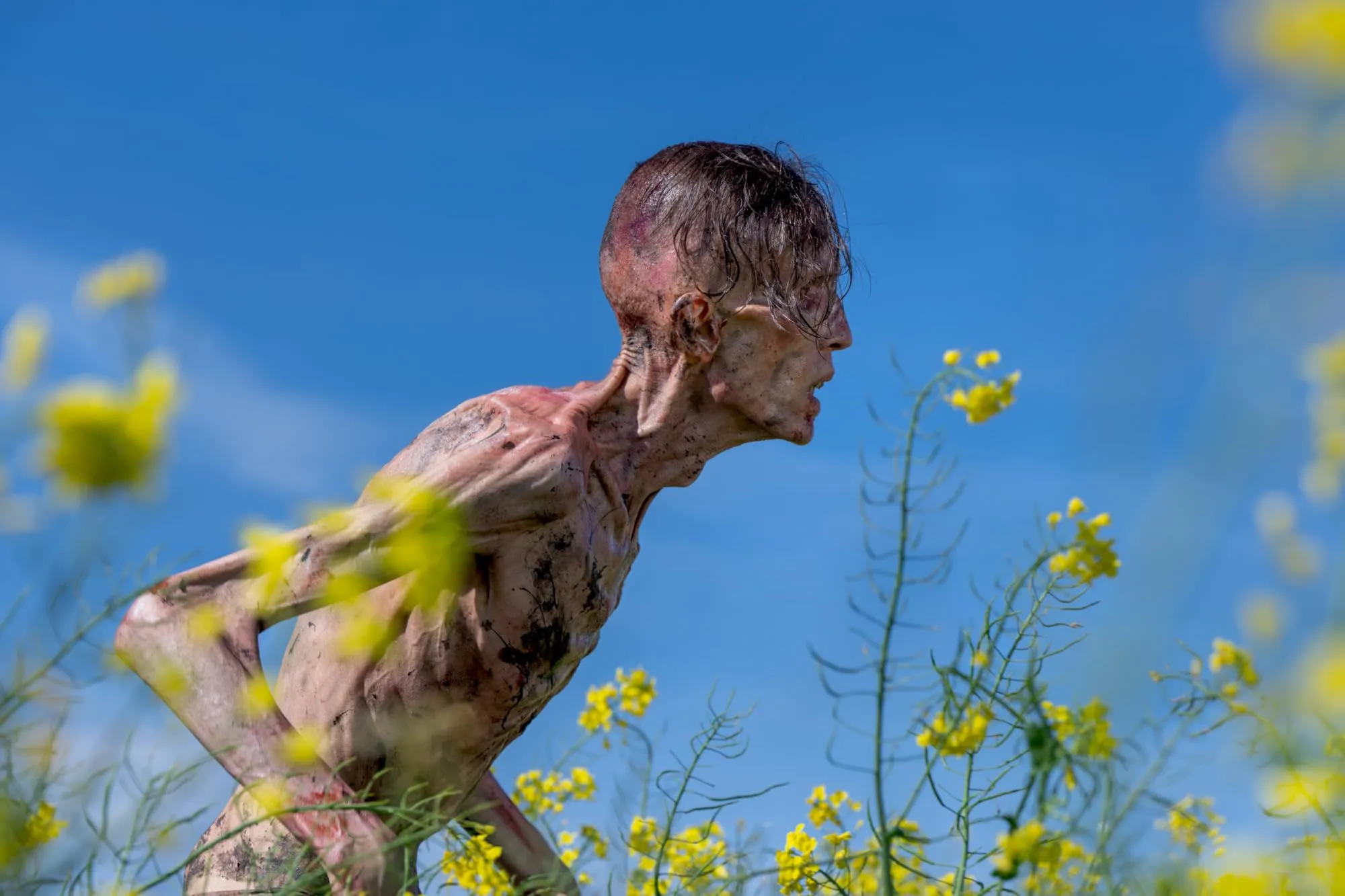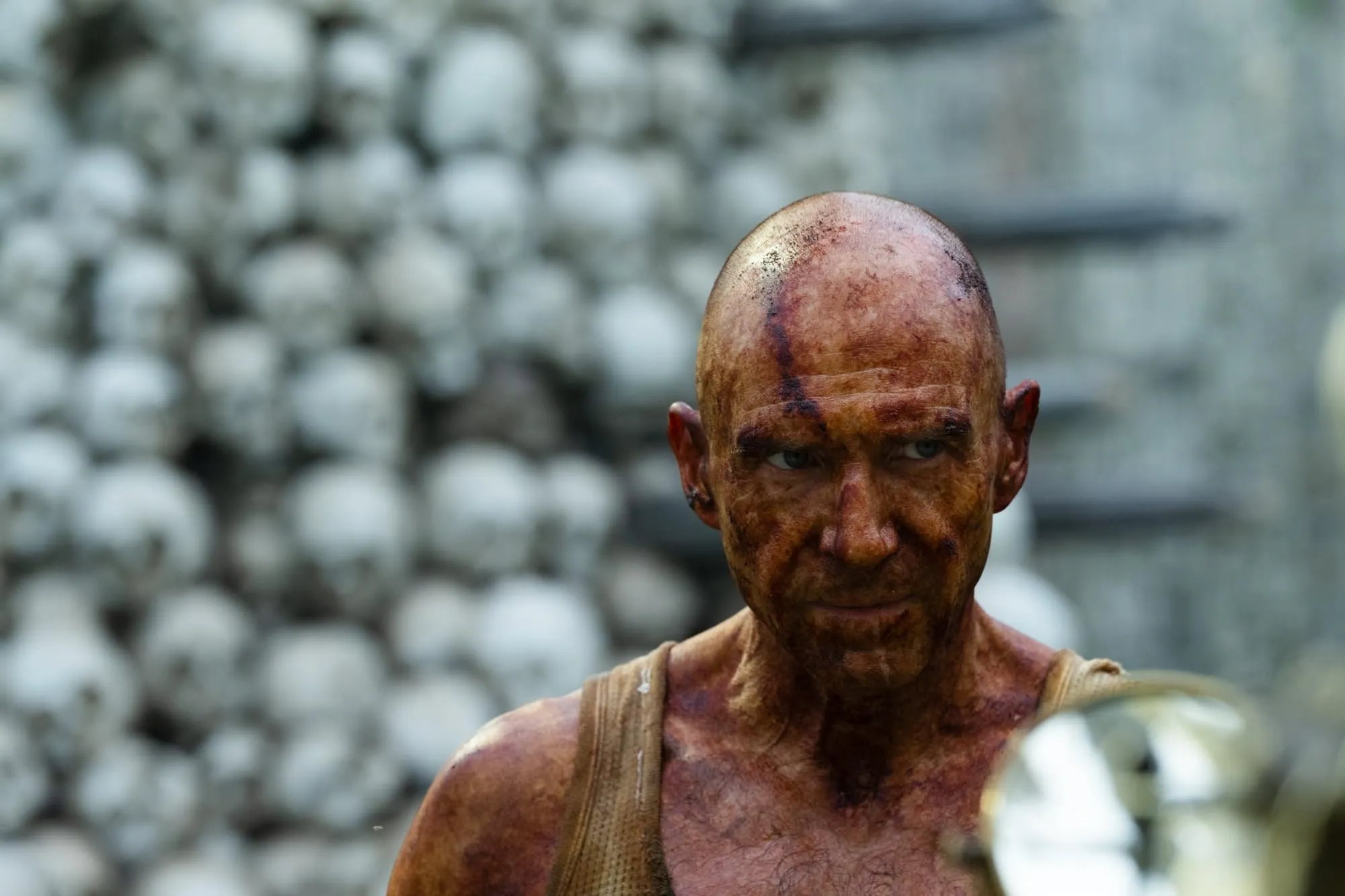Nearly three decades have passed since the Rage virus scoured Great Britain, leaving it a quarantined wound on the global map. In 28 Years Later, the silence that followed the screaming has curdled into a new kind of quiet, a fragile stasis.
On a wind-whipped island off the coast of Scotland, a pocket of humanity has survived by turning backward. Theirs is a world remade in a primitive mold, a society of scavenged ritual and homespun technology, separated from the haunted mainland by a treacherous tidal causeway.
This fragile peace is built on a simple, brutal principle: what is over there, stays over there. The film’s focus, however, rests on a new generation, embodied by a young boy born into this fractured existence. When a crisis strikes at the heart of his family, he is compelled to look across the water not with inherited fear, but with a desperate purpose.
The journey he undertakes promises not just a confrontation with the infected, but a pensive exploration of a world where survival itself is a question steeped in quiet tragedy and ferocious horror. The atmosphere is one of sustained dread, a thoughtful look at what humanity becomes when left completely alone.
A Fortress Against the Future
The world of Holy Island is a carefully constructed anachronism, a bulwark built against the present. Here, survival has necessitated a retreat into a curated past—a strange fusion of medieval toil and the stiff-upper-lip stoicism of 1950s England.
Life is governed by pre-industrial rhythms; men forge arrows by hand, and technological regression feels as much an ideological choice as a practical necessity. This fortress mentality is reinforced by a steady diet of national myth. Spliced-in visions of Olivier’s Henry V and footage evoking past imperial conflicts flicker through the narrative, subconscious programming for a community that has resurrected a pugnacious, warrior spirit to define itself against the encroaching chaos.
Their entire existence pivots on the tidal causeway, a strip of land that is both their salvation and their prison. This umbilical cord to the mainland transforms the act of scavenging into a sacred rite. It is a proving ground where boys become men through the grim ceremony of the hunt, a ritual that hardens them for a world their elders have defined.
The causeway is not merely a path; it is the physical manifestation of their chosen isolation, a constant reminder of the world they have shut out and the carefully policed identity they have forged in its absence.
The Crucible of Kinship
At the story’s center is not the slavering infected, but a family unit cracking under the immense strain of a broken world. Young Spike, played with a fierce vulnerability by Alfie Williams, is a true child of the apocalypse. His understanding of manhood is forged in his father’s stoic image, a narrow ideal of strength and survival learned at the edge of ruin.
Having never known the world before the Rage, his reality is the island’s insular, self-mythologizing code. It is this limited perspective that gives his rebellion its power; his decision to spirit his ailing mother across the causeway is an act of supreme filial devotion, a naive but profound defiance of the accepted order.
His father, Jamie, embodies the hardened pragmatism of this new age. Aaron Taylor-Johnson portrays him as a capable survivor, a bastion of masculine strength whose resilience has been calcified by loss. He is a man who protects his son with grim efficiency but seems to have made a bitter peace with his wife’s decline—a chilling portrait of love eroded by the sheer attrition of survival.
Caught between them is Jodie Comer’s Isla, a ghost haunting her own life. Her mysterious affliction is a constant, fading presence—a fog of memory loss and panicked confusion that renders her physically present but heartbreakingly absent.
She is the narrative’s sorrowful catalyst. Spike’s desperate quest for a cure is a direct rejection of his father’s weary fatalism. The resulting dynamic is a potent, gut-wrenching exploration of familial bonds tested in a crucible where hope itself has become the most dangerous liability.
A Savage Canvas
Danny Boyle directs not with a camera but with a fever. His style remains a frantic, purposeful chaos, a storm of high-intensity action that breaks for moments of startling, dreadful quiet. The film’s texture is deliberately fractured; aggressive jump-cuts and the unsettling insertion of historical footage create a disorienting collage of a nation devouring its own past.
This frenetic gaze is captured through the raw, hyper-anamorphic lens of an iPhone, a choice by cinematographer Anthony Dod Mantle that honors the lo-fi immediacy of the original while creating a distinct visual language. There is a terrible beauty to this apocalypse.
The indifferent majesty of the Scottish highlands, with its verdant greens and bruised-purple skies, becomes a pagan backdrop for unimaginable brutality. Colors pop with a splendid, almost mocking promise against the raw, visceral ugliness of social collapse.
The horror itself is a relentless, kinetic assault. This is a film of blisteringly fast chases, of sinewy spinal cords torn free and viscera painting the landscape. Boyle’s kill shots are fetishized, lingering on the brutal poetry of an arrow finding its mark.
The terror is sustained and breathless, a panic-inducing rhythm that rarely slackens. Fueling this dread is an evolved threat. The classic, sprinting infected are here, their undressed forms a testament to the years of decay. But the ecosystem of horror has grown richer and stranger.
Grotesque, rotund “Slow-Lows” ooze across the muck, and a towering, intelligent “Alpha” emerges as a focused, terrifying predator. This is not simply a horde; it is a developing species of monster, ensuring the peril feels both familiar and chillingly new.
The Heresy of Survival
As the physical journey across the mainland progresses, the film dares to propose its most radical idea: that the clear, sharp line between human and monster is merely a matter of perspective. The narrative begins to question the righteousness of survival itself, suggesting that the infected are not just mindless engines of destruction.
Through the eyes of Spike—a boy new to every part of this world—we are invited to see the plague not as an enemy to be exterminated, but as a state of being, however horrific. This humanizing impulse, so often a cloying misstep in the genre, is here handled with a strange and unsettling grace.
This philosophical pivot finds its anchor in Dr. Kelson, the hermit-doctor played with a magnificent, tender madness by Ralph Fiennes. He is the film’s prophet, a man who has moved beyond the simple, brutal calculus of living and dying.
Kelson’s wisdom is a damning critique of the islanders’ entire worldview. He puts forth the notion that a life lived in militant denial of death becomes a corruption of life itself. His worldview is a shocking alternative to the instinct for self-preservation that has driven every character to this point.
The island community was built on the premise of keeping death at a distance; it is an abstraction that happens “over there,” on the far side of the causeway. For them, memento mori—remember you must die—is a forgotten concept.
Spike’s desperate odyssey to save his mother is therefore transformed into a profound reckoning with mortality. He is forced to learn that out of sight is not out of mind, and that the only way to understand life is to stare into the face of its inevitable, terrifying, and perhaps even sacred, end.
A Saga Begun, Not Ended
The film’s philosophical weight rests on the shoulders of its cast. Alfie Williams is a remarkable discovery, carrying the story’s emotional core with a performance that balances boyish fear with a burgeoning, hard-won gravity.
As his mother, Jodie Comer offers a beautifully understated portrait of decline, her subtle work conveying a world of loss in fleeting moments of clarity. Yet it is Ralph Fiennes’ late-stage arrival that truly alters the film’s trajectory, his transfixing performance as the sage-like Dr. Kelson single-handedly pivoting the narrative from a survival-horror sprint to a meditative inquiry into the nature of existence.
This is a film that ends not with a full stop, but with a brazen ellipsis. The story is explicitly left unfinished, a prologue to the promised next chapter, The Bone Temple. The final act abandons its established tone for a shocking, graphic-novel strangeness, introducing a startling cameo that breaks the somber mood with a promise of a different, wilder conflict to come.
This is not a nostalgic bookend to a beloved classic. It is the ambitious, blood-soaked foundation for a new and perhaps far stranger mythology, a chapter that feels intentionally, thrillingly incomplete.
Released worldwide on June 20 2025 through Columbia Pictures and Sony Pictures Releasing, 28 Years Later is currently screening exclusively in cinemas across major territories.
Full Credits
Director: Danny Boyle
Writers: Alex Garland
Producers and Executive Producers: Danny Boyle, Alex Garland, Andrew Macdonald, Peter Rice, Bernie Bellew, Cillian Murphy
Cast: Jodie Comer, Aaron Taylor-Johnson, Jack O’Connell, Ralph Fiennes, Alfie Williams, Erin Kellyman, Edvin Ryding, Joe Blakemore
Director of Photography (Cinematographer): Anthony Dod Mantle
Editors: Jon Harris
Composer: Young Fathers
The Review
28 Years Later
A triumphant and intellectually ferocious return to the world of the Rage virus. Danny Boyle's direction is a masterclass in kinetic horror, elevated by profound philosophical questions about life and death and anchored by outstanding performances. While its deliberately open-ended nature and jarring final shift mark it as the first chapter of a new saga rather than a self-contained story, it is a brutal, beautiful, and essential piece of filmmaking that breathes startling new life into the genre.
PROS
- Deeply philosophical themes that elevate the horror genre.
- Danny Boyle's energetic and visually stunning direction.
- Powerful performances, especially from Alfie Williams and Ralph Fiennes.
- Intense, visceral, and genuinely terrifying horror sequences.
- Beautiful yet brutal cinematography of the Scottish landscape.
CONS
- The story is explicitly incomplete, ending on a major cliffhanger.
- An abrupt tonal shift in the final moments feels jarring.
- Functions more as a setup for future films than a standalone experience.



















































